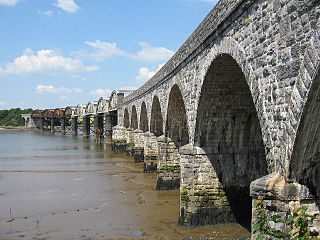
The Tamar is a river in south west England that forms most of the border between Devon and Cornwall. A part of the Tamar Valley is a World Heritage Site due to its historic mining activities.

Callington is a civil parish and town in east Cornwall, England, United Kingdom about 7 miles (11 km) north of Saltash and 9 miles (14 km) south of Launceston.

The Tamar Valley Line is a railway line from Plymouth, Devon, to Gunnislake, Cornwall, in England, also known as the Gunnislake branch line. The line follows the River Tamar for much of its route. Like all railway lines in Devon and Cornwall, it is unelectrified and all trains are diesel powered. The entire line is single track past St. Budeaux Junction.

Bere Alston is a village in West Devon in the county of Devon in England. It forms part of the civil parish of Bere Ferrers.

The Plymouth, Devonport and South Western Junction Railway (PD&SWJR) was an English railway company. It constructed a main line railway between Lydford and Devonport, in Devon, England, enabling the London and South Western Railway (LSWR) to reach Plymouth more conveniently than before.

St Budeaux Victoria Road railway station is a suburban station in St Budeaux, Plymouth, Devon, England. The station is managed and served by Great Western Railway.

Okehampton railway station is a terminus railway station on the Dartmoor line serving the town of Okehampton in Devon, England. The station closed to regular traffic in 1972, but heritage and occasional mainline services ran from 1997 to 2019. Regular railway services resumed in November 2021.

Bere Ferrers station on the Tamar Valley Line is situated near the village of Bere Ferrers in Devon, England. The station is on the former Southern main line between Exeter and Plymouth via Okehampton. It is currently operated by Great Western Railway (GWR).

Calstock railway station is an unstaffed railway station on the Tamar Valley Line serving the village of Calstock in Cornwall, United Kingdom. It is situated at the north end of Calstock Viaduct which carries the railway at high level over the River Tamar.

Gunnislake railway station serves the village of Gunnislake in Cornwall, England. There are also connecting buses from here to the town of Tavistock. However the station is located in or nearer to the villages of Drakewalls and Albaston. It is the northern terminus of the Tamar Valley Line from Plymouth.

The South Devon and Tavistock Railway linked Plymouth with Tavistock in Devon; it opened in 1859. It was extended by the Launceston and South Devon Railway to Launceston, in Cornwall in 1865. It was a broad gauge line but from 1876 also carried the standard gauge trains of the London and South Western Railway between Lydford and Plymouth: a third rail was provided, making a mixed gauge. In 1892 the whole line was converted to standard gauge only.
The East Cornwall Mineral Railway was a 1,067 mm gauge railway line, opened in 1872 to connect mines and quarries in the Callington and Gunnislake areas in east Cornwall, England, with shipping at Calstock on the River Tamar. The line included a rope-worked incline to descend to the quay at Calstock.

The Exeter to Plymouth railway of the London and South Western Railway (LSWR) was the westernmost part of a route competing with that of the Great Western Railway (GWR) and its 'associated companies' from London and Exeter to Plymouth in Devon, England. Whereas the GWR route from Exeter followed the coast to Newton Abbot and then went around the southern edge of Dartmoor, the LSWR route followed the northern and western margins of Dartmoor, passing through the towns of Crediton, Okehampton, and Tavistock.
This article describes the history and operation of the railway routes west of Salisbury built by the London and South Western Railway (LSWR) and allied companies, which ultimately became part of the Southern Railway in the United Kingdom. Salisbury forms a natural boundary between the Southern Railway core routes in the counties surrounding London, and the long route connecting with the Devon and Cornwall lines.

Lydford railway station was a junction at Lydford between the Great Western Railway (GWR) and London and South Western Railway (LSWR) situated in a remote part of north-west Dartmoor in Devon, England.

The network of railways in Plymouth, Devon, England, was developed by companies affiliated to two competing railways, the Great Western Railway and the London and South Western Railway. At their height two main lines and three branch lines served 28 stations in the Plymouth area, but today just six stations remain in use.

Callington railway station was a railway station in the village of Kelly Bray, one mile (1.6 km) north of the centre of the small town of Callington, Cornwall. It was the terminus of a branch line from Bere Alston, built by the Plymouth, Devonport and South Western Junction Railway, but operated by the London and South Western Railway. The station closed in 1966. The Tamar Valley Line still operates services from Bere Alston, with services terminating at Gunnislake railway station, 5 miles (8 km) to the east of Callington.

Tavistock North was a railway station serving the town of Tavistock, operated by the Plymouth, Devonport and South Western Junction Railway, but forming part of the Exeter to Plymouth section of the London and South Western Railway.

Tavy Bridge is a railway bridge across the mouth of the River Tavy just east of its confluence with the River Tamar. It was built by the Plymouth, Devonport and South Western Junction Railway, and the Tavy Bridge was constructed to carry the track over the Tavy Estuary and the adjoining mudflats. The bridge is a Grade II listed building, with both ends being listed separately.
Tavistock railway station is a proposed new station to serve Tavistock in Devon, England, in order to reinstate a rail connection between the town and Plymouth, about 13 miles (21 km) to the south.


















